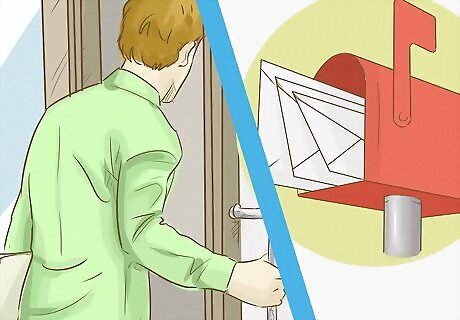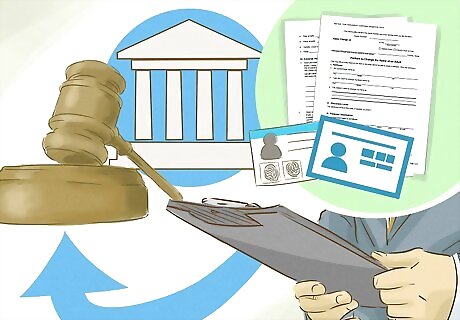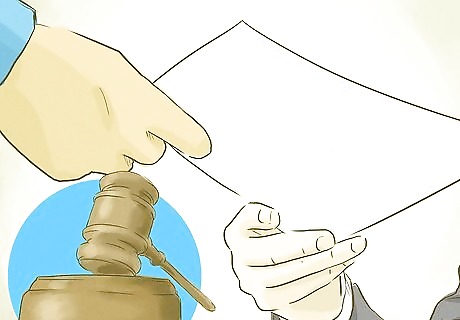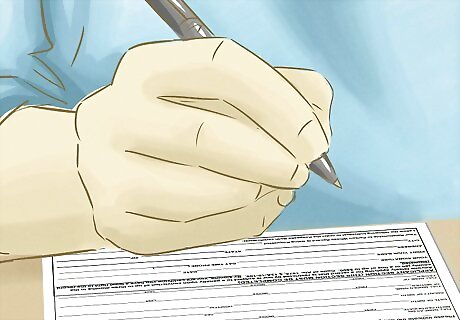
views
Figuring Out Whether Your License Is Suspended

Get a copy of your driving record. Staying informed about your driving record is important for several reasons. It will include your driving history and will note if your license is under suspension. It can also let you know whether there are inaccuracies on your record that you should resolve (such as a traffic ticket that you successfully contested). Depending on your state, you may be able to order your driving record online, over the phone, by mail, and/or in person. Check with your local DMV office to find out how they offer access to your driving record. Some states allow you to order a copy of your driving record online. Most states charge a small fee for obtaining your driving record (usually between $5-$15). Always visit your state’s official DMV/DDS website. The official web portal of the US Government lists each state’s official DMV/DDS website. Remember, most official government websites end in “.gov” in the United States, although some -- such as Oklahoma’s Department of Public Safety -- end in “.us”. Going through the official government portal will ensure you get to the right website. Never enter your personal information on a website that says it will give you a copy of your driving record for free. Official websites do not require “sign-up” fees, either. Websites that offer “free” driving record copies or require “sign-up” or other “service” fees are usually phishing scams intended to access your personal information. Some states require you to appear in person at the DMV office to get a copy of your driving record. Bring proper photo identification and the fee (which will vary by state). Some states allow you to order a copy of your driving record by mail. Fill out a form (which you can get online or at a local DMV office) and include a photocopy of your driver’s license and the fee.

Contact your local DMV or DDS and ask about the status of your license. A DMV representative will usually be able to tell you if your license is valid or suspended. He or she may also be able to tell you why your license has been suspended and what you need to do to reinstate it. Sometimes, you must go to the DMV in person to get this information. However, many states have an online service that will tell you if your license is suspended. Check your state’s DMV or DDS website for their regulations.

Look for a copy of a suspension notice that was mailed to you. In most states, suspension notices will be mailed to you. If your address is currently on file with the appropriate agency (such as the Department of Public Safety or Department of Licensing), you should have received a letter with details of your suspension. In many cases, these letters will also include a hearing request form. You can return this form if you wish to request a hearing to argue against the suspension.

Understand why suspensions happen. There are several reasons why your driver license might be suspended. Common reasons include repeat violations (excessive speeding, reckless driving, etc.), serious violations (such as DUI/DWI), and unpaid fines. However, these are not the only reasons to suspend a license. Even if none of these reasons apply to you, you may want to investigate and make sure your license is not suspended. It's possible that inaccuracies on your driving record can cause a suspension that should not have happened. For example, if your record reflects tickets that you didn’t get, your license might be suspended.

Keep track of your license points. Most states have a point system that assigns a certain number of points to each moving violation (traffic violations that occur while the vehicle is moving, such as running a stop light or speeding). If you reach the maximum number of allowed points, your license will be suspended for a predetermined amount of time. The number of days that your license is suspended is usually determined by the number of points on your record. For example, in Alabama, 12-14 points within a 2-year period results in a suspension of 60 days, but 24+ points within a 2-year period results in a suspension of 365 days. Usually, you won’t get a suspension for a single moving violation. However, if a driver commits certain serious traffic offenses – such as speeding 15 or more miles per hour above the posted limit, or reckless driving – multiple times within a certain time period, many states will suspend the driver’s license.

Think about whether you have committed any major driving offenses. In most states, some serious driving offenses, such as driving while intoxicated, will immediately suspend your license. Other offenses that usually result in immediate suspension include: Vehicular homicide Felonies involving a motor vehicle Leaving the scene of an accident Evading the police

Check your auto insurance. If you're pulled over or involved in an accident, you will be asked to show proof of insurance. Not having valid proof of insurance can result in a suspended license. If you were pulled over or in an accident and couldn't show proof of insurance, your license may have been suspended. If you’ve left your proof of insurance at home, check with your DMV office to see if your state allows you to bring the proof of insurance to the DMV before your license is suspended.
Handling Suspension

Understand the rules of suspension in your state. When your license is suspended, you cannot legally drive for the period of suspension. If you’re caught driving with a suspended license, you may incur serious penalties. These could include additional suspension time, heavy fines, and even jail time. Check with your state’s DMV to learn the full rules. Some states, such as Florida, require you to turn in your license to the DMV following a suspension. If your state requires you to turn in your license, the mandated suspension period will not start until you do so. In other words, if your license is suspended for 60 days but you don’t turn in your license for 30 days, the 60-day suspension period will not start until you turn in your license. However, your license would still be suspended for the 30 days before you turned it in. Having the license in your possession does not mean you can legally drive. Failure to turn in your license when required to do so usually results in an extended suspension period.

Ask for a hearing. In many cases, you are entitled to a hearing where you can appeal your license suspension. For example, in Washington you will be sent a hearing request form with the suspension notification letter. You can complete it and mail it in to request a hearing. In other cases, there may be special forms or procedures you need to take care of in order to request a hearing. There are several reasons why you might request a hearing. For example, if you believe the violations on your driving record should not have been issued, you should use the hearing to explain why. You could argue financial hardship by showing that if you’re unable to drive to work you might lose your job. You can also discuss the facts of any traffic accidents. For example, some states will assign points to your license for any traffic accident, regardless of fault. Providing details, such as from your auto insurance company or an accident report, that show the accident was not your fault may persuade the hearing officer that your license should not be suspended.

File an appeal. If your license was suspended because of an alcohol-related offense, you can usually appeal the suspension. To find out details and specifics about appealing, visit or call your state’s DMV office. Keep in mind that appealing the DMV’s decision to suspend your license does not affect any civil or criminal case against you stemming from the incident. In many cases, these appeals cost substantial fees (for example, in Georgia, appealing a DUI suspension costs $150). These appeals must usually be made within a certain time-frame after the suspension. Check with your local DMV office for your states’ regulations.

Ask about traffic school. In some states, you may be able to reinstate your license if you complete traffic school or a state-approved defensive driving course. Check with your state’s DMV or similar department for their policy. If your license was suspended due to a points violation, you may usually reinstate your license by completing traffic school or a defensive driving course.

Investigate a “hardship license” option. In some states, you may be eligible to apply for a “hardship license” even if your driver’s license has been suspended. These licenses are temporary. They are only meant for you to be able to do necessary driving, such as to and from work or to go buy groceries. In some cases, an “ignition interlock device” may be installed in your car if you get a hardship license. These are usually for alcohol-related suspensions and will not allow your car to start if you’re intoxicated.
Reinstating Your License

Wait the required amount of time. If your license was suspended for a specific amount of time, for example 60 days, you must wait until that suspension period has completed before you can apply to reinstate your license. Remember that if you must turn in your license, your official suspension period will not start until you comply.

Apply to reinstate your license. You can’t just begin driving again after the suspension period is over. You must complete certain requirements to officially reinstate your license before you can legally drive. These requirements will differ by state, so check with your state’s DMV to learn what you have to do to reinstate your license.

Pay a fee. In most states, you will need to pay a fee to have your license reinstated. The amount of this fee varies dramatically. If you live in a state that requires you to turn in your license, you must usually also pay a fee to get a new license made. For example, in Massachusetts, the reinstatement fee is $100. In Minnesota, it is only $20. The fee may also vary depending on why your license was suspended. if your license was suspended for driving under the influence of drugs or alcohol, or for criminal activity involving a vehicle, the fee will probably be much higher than for other suspensions.

Provide proper documentation. Most states require you to do things like complete traffic school or participate in a substance abuse education program as part of your suspension. If you were required to do anything like this, you’ll need to provide documentation that you fulfilled the requirements. Make a copy of your documentation for your records. Sometimes, records can get lost, and you will want to be sure that you can prove you completed all the requirements.

Provide an insurance form. Most states require you to fill in and submit an “SR-22” form to reinstate your license. The SR-22 form certifies that you carry at least the minimum auto insurance required by your state. In most states, you will need to have your insurance provider submit this form directly to the the DMV or other agency. Most states require these forms to be filed for 3 years. If you’re accident-free for that period, you will not need to continue filing the SR-22.

Comply with any other requirements. Depending on the terms of your suspension, you may need to comply with other requirements to reinstate your license. Make sure that you complete all certifications, education programs, etc. before you apply to reinstate your license. For example, if your suspension was the result of a DUI, you may pay all of your court costs and fines before you can reinstate your license.



















Comments
0 comment